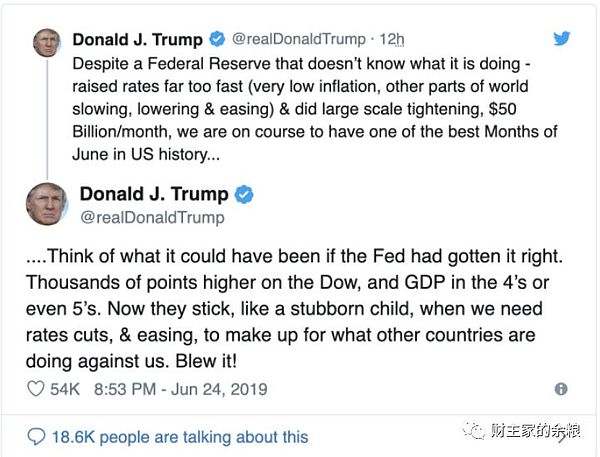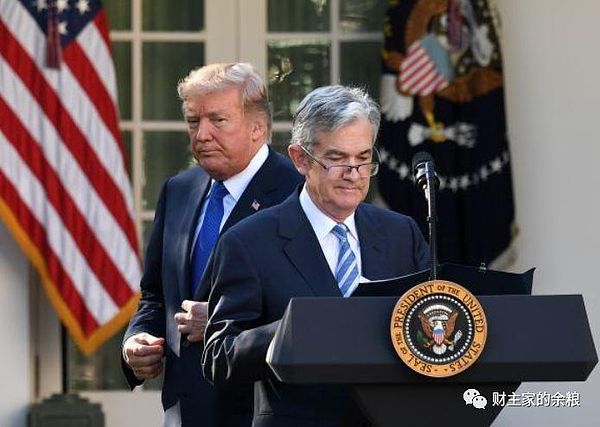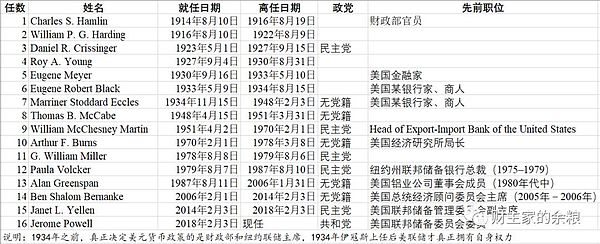
Source: Yu Liang from the rich man’s family Note: This article was first published in June 2019
In the past week, Trump has once again confronted Federal Reserve Chairman Powell.

Trump rambled like Xianglin Sao, saying that if the Fed did not raise interest rates, the Dow Jones Index could have risen by thousands more points, and GDP growth could reach a range of 4% or even 5%…
On June 26, Trump once again criticized Powell for not lowering interest rates and made an authoritative claim in an interview with Fox Business Network:
“I have the right to downgrade him, I have the right to fire him.”
So, can the US president really fire the Fed chairman?
Former Federal Reserve Chairman Ben Bernanke wrote a book called “The Courage of Action: Memoirs of the Financial Crisis and Its Aftermath”, which has a clear answer to this question.
“The Fed’s Board of Directors consists of seven executive directors, including a chairman, a vice chairman and five other executive directors. They must all be nominated by the president and can only take office after confirmation by Congress. Each executive director has a term of 14 years (the term of 4 years for the Fed’s Chairman). The term of the seven executive directors needs to be separated by two years. If a director resigns, the president can appoint a new director in a timely manner. Therefore, there are only two executive directors in the four-year term of office of the US president. The president needs to decide who the new candidate is.”
“The Fed is a central bank with political independence. It is a reason for its existence to make politically unpopular decisions for the long-term interests of the country. Its goal is exactly what it is: to do what others cannot or are unwilling to do, but must do.”
“As early as 1978, Congress stipulated that the Government Audit Office had no right to interfere in the process of monetary policy development, because Congress believed that the Federal Reserve’s monetary policy was intended to achieve long-term economic interests of the United States and could not be interfered with by short-term political pressure (but the Federal Reserve’s situation in performing multiple functions such as banking supervision must be evaluated by the Government Audit Office).
“The Fed will not succumb to any pressure, but will instead strive to get rid of all political interference. As a politically independent central bank, we have to be cautious. As long as we are responsible for achieving the goals set by Congress for us, it is the best choice for our country to develop monetary policies without political interference. If we try to exert influence on fiscal issues beyond our jurisdiction, then we should not expect elected leaders to respect the Fed’s long tradition of autonomy.”
The answer is obvious:
The president has the right to appoint the Fed chairman, but does not have the right to fire the Fed chairman.
The Fed cannot swear at the government’s fiscal policy, and the government has no right to swear at the Fed’s monetary policy.
Legally speaking, Trump accused Powell of crossing the line.
Bernanke also has a book called “The Essence of Finance”, which mentions the source of Fed’s independence:
“Until 1951, after long and complicated negotiations, the U.S. Treasury Department finally agreed to let the Federal Reserve set interest rates on its own as needed to achieve economic stability. The two sides signed the Federal Reserve-Treasury Agreement in 1951, which is of great significance because this is the first time the U.S. government has clearly recognized that the Federal Reserve is allowed to operate independently.”
“In today’s world, countries have formed a general consensus that central banks will have better results than government-led operations. In particular, an independent central bank can ignore short-term political pressures, such as being forced to stimulate the economy for elections. In this way, central banks can take some long-term measures and achieve better results.”

In December 1913, the U.S. Congress passed the Federal Reserve Act, and the Federal Reserve was established, and the bill clearly stated,“The Fed does not interfere with any executive branch, including the president, when formulating monetary policy.”.
However, the Federal Reserve was established under the jurisdiction of the Treasury Department, and the first chairman of the Federal Reserve was Assistant Secretary of the Treasury Department.For a period of time, the Secretary of the Treasury was a natural director of the Federal Reserve and could influence monetary policy formulation. The Federal Reserve was only a vassal of the Treasury.
In 1934, Echos took office as chairman of the Federal Reserve, and he disqualified the Fed Secretary and the Director of the Registrar of the Currency Supervision Office, but he also believed that the Fed should supplement fiscal policy and assist the government in promoting credit.Since then, until the beginning of the end of World War II, the Federal Reserve’s monetary policy was basically subordinate to the fiscal policy of the Treasury and maintained ultra-low interest rates to help the government raise funds.
In March 1951, the Federal Reserve and the Treasury reached a “Federal Treasury Agreement”. The Federal Reserve nominally deviated from the influence of the government and could independently formulate monetary policies. However, in fact, the Federal Reserve and the Treasury are still very close, and most of the time, monetary policy also cooperates with the Treasury requirements.
After William Martin became the chairman of the Federal Reserve, the United States fell into the Vietnam War, and the scale of fiscal spending expanded sharply, and it needed to support it with loose monetary policy. However, Martin did not act as President Johnson’s wishes and left a famous saying:
“The Fed’s job is to remove the big glass at the beginning of the banquet.”
By 1965, then-President Johnson even asked the Justice Department whether Martin could be removed, but lawyers suggested that policy objections did not constitute a reason to remove the Federal Reserve Chairman.
In 1970, Nixon nominated Burns as chairman of the Federal Reserve and left his own “famous quote”:
“I would respect his independence, but I personally hope he can make decisions that follow my will. You know, Mr. Burns, I support low interest rates and more money supply for a long time.”
Well, Burns cooperated with Nixon and implemented loose monetary policies, which resulted in the surge in US inflation in the late 1970s, bringing the entire US economy into a mud pit.
FedrealThe independence comes from Paul Volker, who served as chairman of the Federal Reserve in 1979.
Burns cooperated with the Treasury Department to implement loose monetary policies, which caused severe stagflation. After Volcker came to power, he withstood various pressures, was brave enough to take responsibility, continuously raised interest rates, and cured long-term symptoms at a short-term cost. The Federal Reserve’s prestige increased greatly, which made all walks of life realize the long-term benefits of giving the central bank independent operation of monetary policies.
After Reagan came to power, he invited Volker to the White House for talks, but was rejected. He took the initiative to express his willingness to visit Volker at the Federal Reserve headquarters, but was rejected again, which made Reagan very depressed. It was also during the Volker period that the United States formed a political tradition of the government’s monetary policy.
Later, Reagan’s nominated Greenspan as chairman of the Federal Reserve for 18 years, during which he experienced Republican Presidents Reagan and Bush Sr., Clinton of the Democratic Party, and Bush Jr., and when Bush Sr. was not catered to the president’s needs and lowered interest rates at the critical moment of Bush’s re-election campaign, his position has always been as stable as Mount Tai.
When Greenspan chose to retire, Bush chose Bernanke, who was slightly politically inclined toward the Democratic Party.
In the fall of 2006, Bernanke’s daughter’s friend asked her what her father did, and her daughter said that my dad was the chairman of the Federal Reserve.The classmate was stunned and responded – “Is your dad Greenspan?”
This response just reflects that in the consciousness of ordinary people, the Federal Reserve Chairman can continue to do it and will not be disturbed by the president’s appointment.
After Bernanke, Yellen, and then Powell, the situation of successive Federal Reserve chairmen is shown in the table below.

Faced with the threat of Trump’s frequent “dismissal”, Powell made it clear that the US law is very clear. He has a four-year term and is very willing to complete the term of chairman.The Federal Reserve Chairman, who succumbed to presidential pressure and relaxed money in history, has caused serious financial and economic problems and is generally poorly known. Powell is well aware of this. In this sense, if he does not consider re-election, he does not need to cater to Trump in monetary policy.
If you really want to replace Powell, Trump must run for the next president first. Until Powell’s term ends, he can reappoint a Federal Reserve chairman, but at this time, there is only more than a year left before Trump completely leaves the presidency…
There is another way.US law stipulates that the Fed is responsible to Congress, and if there is any serious misconduct by the Fed chairman, the U.S. Congress can fire it.Therefore, Trump can incite a certain lawmaker to launch a proposal to fire Powell and pass it in Congress, and the president can sign it – but it is probably not much easier for Trump to achieve this than he runs for president.
To put it bluntly, unless there is an extreme situation in US politics, it is extremely unlikely that Trump can replace Powell during his term as Fed Chairman. Powell may consider the situation facing the US economy, but Trump’s saliva pressure is of little significance to the Fed. Although Trump has always opposed it, from the beginning of 2018 to the present, the balance sheet contraction has been following the pace of balance sheet reduction determined by the Federal Reserve when Yellen was in office. In the past six months, the monthly reduction of $50 billion has not been reduced due to Trump’s accusations.









